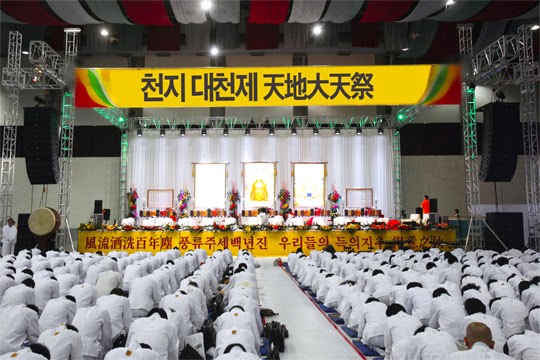The Cheonje (天祭) is a traditional sacred ritual for the worship of the heavenly emperor (上帝) and spirits (天神) in heaven which has been performed since ancient time.
It is the most great and wonderful event for us to show our gratitude for the grace of heaven and earth and our ancestors, and for us to vow to live the united life with our ancestors in order to attain the oneness with the will of heaven and earth.
The Cheonje is the most glorious festival for us to be refreshed and awakened about the true meaning and value of human life. And it used to be the nationwide great festival of a country.
The current culture of human civilization provides us materially convenient life but spiritually depraved and superficial. Thus, people just consider that the Cheonje might be the myth or legend in history and they don't understand the real meaning of the Cheonje ritual. However, in "Hwandangogi" remains the reality of Cheonje culture purely.
To the Holy Spirit of heaven and earth and Sangjenim, Taemonim, and all spirits living within the Holy Spirit of creative change, do we make an oath and pray to live the illgoon's life for fulfilling the will of heaven and earth, and firmly vow to accomplish the great work of heaven and earth no matter what happens.
Just attending the Cheonje (天祭) as a member of protagonists of the event, that itself is a great ineffable blessing and honor. It is indeed so much blessed work.
(From the speech of His Holiness Jeungsando Jongdosanim, Dao year November 141; 道記 141. 11)
-Roughly translated on June 20, 2014-
The Cheonje (天祭); the Chiseong ritual to Heaven is the archetypal culture of human civilization. Where did it start at first and what is the principle or philosophy of this ritual? That is the key to know the origin of this human civilization.
Niuheliang is a large burial site scattered over hill tops over a 50 square kilometer area. It features a unique temple on a loam platform, with an altar and cairn complex, covering an area of around 5 km². The altar at Niuheliang was made of stone platforms, supported by painted, clay cylinders. A north-south axis connects this temple complex with a central peak of the Zhushan mountains, otherwise known as "Pig Mountain". The subterranean ritual complex was built on a ridge and decorated with painted walls, referred to by Chinese archaeologists as the Goddess Temple, due to the discovery of a clay female head with jade inlaid eyes
Reference:
Niuheliang (牛河梁)




No comments:
Post a Comment